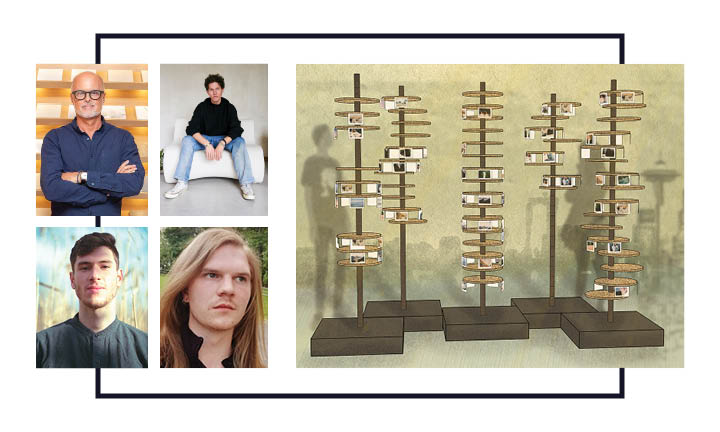Curiosity is at the core of what Stroop Design does and how they think. As a global design studio with team members in Seattle, New York, London, and Buenos Aires, they explore the impact and influence of design in different settings and retain an inquisitive nature that keeps their eyes open to the world.
Working across hospitality, wellness, and residential projects, Stroop Design loves exploring the cross pollination of ideas and exploring the nuances of design when applied to specific projects and locations. It’s through curiosity that design issues have creative solutions. And more broadly, it’s through curiosity that design can be used to address wider issues in the social and environmental spheres.
Stroop helped celebrate curiosity at Seattle Design Festival with their pop-up experience, Curiosity Click. Curiosity fuels what they do, and they enjoyed cultivating interactions that prompted new and different views of the world with the hope that continual discovery can help improve our joint experience on this planet.
Vince Stroop (he/him) | Founder at stroop
Dakota Smith (he/him) | Creative Strategist at stroop
Kyle Blute (he/him) | Architectural Designer at stroop
Ben Fox (he/him) | Architectural Designer at stroop
CURIOSITY in design is…
Vince Stroop: Asking the “what ifs. Asking questions that entail exploring, listening, and paying attention to the sensory clues of an environment which perhaps lead to a “discovery.
For me, the camera has always been a “go-to” tool for curiousness allowing me to focus a kinetic world through a small, fixed frame and then use this visual inventory to create a narrative and/or to make design decisions.
Our immersive pop-up installation builds on this notion and encourages visitors to use their own eye to frame what intrigues them throughout the festival, what makes them “curious” and allows them to engage, not only with just our exhibition, but the entire community of participants.
How do you use CURIOSITY in your work?
Dakota Smith: Curiosity is a way to challenge perspectives and elicit thought. By being exploratory in my own work, I can help stimulate the curiosity in others. This keeps creation fresh and presents opportunities for creating work that is more reflective and impactful.
Who or what inspires you?
Ben Fox (BF): What inspires me is the psychological, emotional, and physiological relationship between people and the spaces and objects we spend time in and interact with, both in the natural world and the built environment.
In other words, the fact that a beautiful room, the smell of a garden, the sunlight through the trees of a forest, or a smooth finish on a piece of furniture can cause us to experience happiness, wonder, relaxation, and even health benefits. As designers, we have the capacity to bring the serenity of a mountain view into a building in the middle of a city, or the living room in someone’s home.
I also believe that with this capacity comes a responsibility to try and make the psychological, emotional, and physiological benefits of a well-designed space or a well-designed object more accessible to all people. As designers, that is the means by which we can contribute to making the world a better place, and I find that opportunity to be a driving force in my inspiration.
Tell us about a project that you completed that you are most proud of.
BF: The project I am most proud of is the free-standing cabinet I made during my time spent at the Center for Furniture Craftsmanship in Rockport, Maine. The opportunity to produce work while at a furniture school allowed me to explore design and craftsmanship in a context unlike the normal working environment. With no strict timeline, no client, and complete freedom of design, I was able to approach a piece of furniture through an unobstructed artistic lens. I could dive into tangential, experimental journeys and spend days micro-adjusting the smallest of details, developing a new perspective with which I began to view the process of design and craftsmanship.
During my time at the Center for Furniture Craftsmanship I spent many long, hot, dusty days in the un-conditioned machine shop. I would end every day with a swim at Megunticook Lake, rain or shine. In fact, the rain became some of my favorite time to be there. I could stand on a rock, under the overhanging branches of a tree and watch the droplets decorate the surface of the shallow water around me. Standing still amidst a peaceful and rhythmic chaos.
What design object or story most strongly influenced your interest in design?
Kyle Blute (KB): Wheelchair Ramps. I love the question and the challenge of asking if accessibility was the priority.
What is your ultimate goal when it comes to your work? What do you want to contribute?
KB: I want to see architecture as a practice of growth and healing. I want to ask and embody the “what if we did better” question as a way of life and a practice that develops ideas from theoretical concepts to the actual tangible environment. What if Architecture was a radically accessible space for changing and growing a better world?
If you could have one superpower what would it be and why?
KB: To open any door to any place in the world. Wouldn’t it be amazing to be able to open your front door to any place in the world without having to get on a plane?
How should community influence design?
KB: Community is design. If a design ignores community, its effects can be detrimental to the people living and working within a project; if design works in concert, it creates a symphony.
Communities are the core of what we do as architects; they’re our entire profession and providing solutions and developing ideas that strengthen the built environment that groups of people occupy is essential for architecture as a developing practice.





